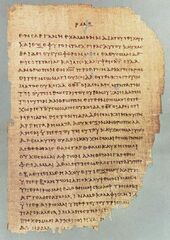- The Pastoral Epistles are often considered together, as each throws light upon the others.
The Epistle to Titus is a book of the canonic New Testament, one of the three so-called "pastoral epistles" (with 1 Timothy and 2 Timothy). It is offered as a letter from Paul to the Apostle Titus.
Authorship and date[]
Traditional view[]
According to Easton's Bible Dictionary (1897), "Paul's Authorship was undisputed in antiquity, as far as known, but is frequently doubted today. It was probably written about the same time as the First Epistle to Timothy, with which it has many affinities."
William Paley wrote in Horae Paulinae (1785), "Both letters were addressed to persons left by the writer to preside in their respective churches during his absence. Both letters are principally occupied in describing the qualifications to be sought for in those whom they should appoint to offices in the church; and the ingredients of this description are in both letters nearly the same. Timothy and Titus are likewise cautioned against the same prevailing corruptions, and in particular against the same misdirection of their cares and studies.
"This affinity obtains not only in the subject of the letters, which from the similarity of situation in the persons to whom they were addressed might be expected to be somewhat alike, but extends in a great variety of instances to the phrases and expressions. The writer accosts his two friends with the same salutation, and passes on to the business of his letter by the same transition (comp. 1 Tim. 1:2, 3 with Titus 1:4, 5; 1 Tim.1:4 with Titus 1:13, 14; 3:9; 1 Tim. 4:12 with Titus 2:7, 15)."
Traditionalists date its composition from the circumstance that it was written after Paul's visit to Crete (Titus 1:5). That visit could not be the one referred to in Acts 27:7, when Paul was on his voyage to Rome as a prisoner, and where he continued a prisoner for two years. Thus traditional exegesis supposes that after his release Paul sailed from Rome into Asia, passing Crete by the way, and that there he left Titus "to set in order the things that were wanting." Thence he would have gone to Ephesus, where he left Timothy, and from Ephesus to Macedonia, where he wrote the First Epistle to Timothy, and thence, according to the superscription of this epistle, to Nicopolis in Epirus, from which place he wrote to Titus, about A.D. 66 or 67.
Critical view[]
On the basis of the language and content of the Pastoral Epistles, many scholars today doubt that they were written by Paul, and believe that they were written after his death. Critics examining the text fail to find its vocabulary and literary style similar to Paul's unquestionably authentic letters, fail to fit the life situation of Paul in the epistles into Paul's reconstructed biography, and identify principles of the emerged Christian church rather than those of the apostolic generation.
Conversely, those who ascribe the books to Paul find their placement fits within his life and work (as above), and see the linguistical differences as complementary to differences in the recipients. Other Pauline Epistles have fledgling congregations as the audience, the Pastoral Epistles are directed to Paul's close companions, evangelists whom he has extensively worked with and trained. In this view, linguistic differences are to be expected, if one is to assert Pauline authorship to them. However, evidently scholars have seen the arguments against Pauline authorship as significantly convincing, since over two thirds contest it.
See also[]
- Epistle to Titus (text)
- Authorship of the Pauline epistles
External links[]
Online translations of the Epistle to Titus:
| This page uses Creative Commons Licensed content from Wikipedia (view authors). |
